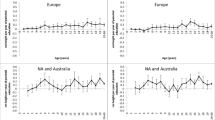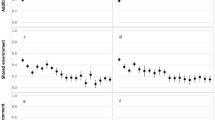Abstract
In 1918, Fisher suggested that his research team had consistently found inflated cousin correlations. He also commented that because a cousin sample with minimal selection bias was not available the cause of the inflation could not be addressed, leaving this inflation as a challenge still to be solved. In the National Longitudinal Survey of Youth (the NLSY79, the NLSY97, and the NLSY-Children/Young Adult datasets), there are thousands of available cousin pairs. Those in the NLSYC/YA are obtained approximately without selection. In this paper, we address Fisher’s challenge using these data. Further, we also evaluate the possibility of fitting ACE models using only cousin pairs, including full cousins, half-cousins, and quarter-cousins. To have any chance at success in such a restricted kinship domain requires an available and highly-reliable phenotype; we use adult height in our analysis. Results provide a possible answer to Fisher’s challenge, and demonstrate the potential for using cousin pairs in a stand-alone analysis (as well as in combination with other biometrical designs).

Similar content being viewed by others
References
Anderson KG (2006) How well does paternity confidence match actual paternity? Evidence from worldwide nonpaternity rates. Curr Anthropol 47:513–520
Beasley WH, Rodgers JL, Bard DE, Hunter M, Garrison SM, Meredith K (2015) NlsyLinks: utilities and kinship information for research with the NLSY R package. https://cran.r-project.org/web/packages/NlsyLinks. Accessed 5 Aug 2019
Boutwell BB, Connolly EJ, Barbaro N, Shackelford TK, Petkovsek M, Beaver KM (2017) On the genetic and environmental reasons why intelligence correlates with criminal victimization. Intelligence. https://doi.org/10.1101/113712
Burt SA, Verhulst B, Neiderhiser J (2018) Abstract: a novel family-based model to evaluated the role of mitochondrial DNA in neuropsychiatric phenotypes. Behav Genet 48:461
Coyne CA (2014) Quasi-experimental approaches to understanding the causes and consequences of teenage childbirth. Dissertation, Indiana
D’Onofrio BM, Van Hulle CA, Waldman ID, Rodgers JL, Harden KP, Rathouz PJ, Lahey BB (2008) Smoking during pregnancy and offspring externalizing problems: an exploration of genetic and environmental confounds. Dev Psychopathol 20:139–164. https://doi.org/10.1017/s0954579408000072
D’Onofrio BM, Goodnight JA, Van Hulle CA, Rodgers JL, Rathouz PJ (2009) A quasi-experimental analysis of the association between family income and offspring conduct problems. J Abnorm Child Psychol 37(3):415–429
D’Onofrio BM, Slutske WS, Turkheimer E, Emery RE, Harden KP, Heath AC, Madden PAF, Martin NG (2007) Intergenerational transmission of childhood conduct problems: a children of twins study. Arch Gen Psychiatry 64:820–829
Fisher RA (1915) Frequency distribution of the values of the correlation coefficient in samples of an indefinitely large population. Biometrika 10(4):507–521. https://doi.org/10.2307/2331838.hdl:2440/15166
Fisher RA (1918) The correlation between relatives on the supposition of Mendelian inheritance. Trans R Soc Edinburgh 52:399–433
Flegal K, Cole T (2013) Construction of LMS parameters for the Centers for Disease Control and Prevention 2000 growth charts. Natl Health Stat Rep 63:1–3
Fowler JH, Baker LA, Dawes CT (2008) Genetic variation in political participation. Am Polit Sci Rev 102:233–248
Garrison SM, Rodgers JL (2016) Casting doubt on the causal link between intelligence and age at first intercourse: a cross-generational sibling comparison design using the NLSY. Intelligence 59:139–156
Garrison SM, Rodgers JL (2019) Decomposing the causes of the socioeconomic status-health gradient with biometrical modeling. J Pers Soc Psychol. https://doi.org/10.1037/pspp0000226
Geronimus AT, Korenman S, Hillemeier MM (1994) Does young maternal age adversely affect child development? Evidence from cousin comparisons in the United States. Popul Dev Rev 20:585–609
Goodnight JA, Lahey BB, Van Hulle CA, Rodgers JL, Rathouz PJ et al (2012) A quasi-experimental analysis of the influence of neighborhood disadvantage on child and adolescent conduct problems. J Abnorm Psychol 121:95–108
Hadd A, Rodgers JL (2017) Intelligence, income, and education as potential influences on a child’s home environment: a (maternal) sibling-comparison design. Dev Psychol 53:1286–1299
Hallquist MN, Wiley JF (2018) MplusAutomation: an R package for facilitating large-scale latent variable analyses in Mplus. Struct Equ Model 25(4):621–638. https://doi.org/10.1080/10705511.2017.1402334
Hamilton NE, Ferry M (2018) ggtern: ternary diagrams using ggplot2. J Stat Softw Code Snippets 87(3):1–17. https://doi.org/10.18637/jss.v087.c03
Jaffee S, Van Hulle C, Rodgers JL (2011) Effects of non-maternal care in the first three years on children’s academic skills and behavioral functioning in childhood and early adolescence: a sibling comparison study. Child Dev 84:1076–1081
Johnson W, Turkheimer E, Gottesman I, Bouchard TJ (2010) Beyond heritability: twin studies in behavioral research. Curr Dir Psychol Sci 18:217–220
Lahey BB, D’Onofrio B (2010) All in the family: comparing siblings to test causal hypotheses regarding environmental influences on behavior. Curr Dir 19:319–323. https://doi.org/10.1177/0963721410383977
Lai C-Q (2006) How much of human height is genetic and how much is due to nutrition. Scientific American, Nature America, Inc. http://www.scientificamerican.com/article/how-much-of-human-height/. Accessed 5 Aug 2019
Larmuseau MHD, Matthijs K, Wenseleers T (2016) Cuckolded fathers rare in human populations. Trends Ecol Evol 31:327–329
Liang KY, Zeger SL (1986) Longitudinal data analysis using generalized linear models. Biometrika 73(1):13–22
Lopez Turley RN (2003) Are children of young mothers disadvantaged because of their mother’s age or family background? Child Dev 74:465–474. https://doi.org/10.1111/1467-8624.7402010
Miller WB, Bard DE, Pasta DJ, Rodgers JL (2010) Biodemographic modeling of the links between fertility motivation and fertility outcomes in the NLSY79. Demography 47:393–414
Muthén LK, Muthén BO (2015) Mplus user’s guide, 7th edn. Muthén & Muthén, Los Angeles, CA
Neale MC, Boker SM, Xie G, Maes HH (2003) Mx: statistical modeling, 6th edn. Department of Psychiatry, Richmond, VA
Prescott CA (2004) Using the Mplus computer program to estimate models for continuous and categorical data from twins. Behav Genet 34:17–40
R Core Team (2018) R: a language and environment for statistical computing. R Foundation for Statistical Computing, Vienna, Austria. URL https://www.R-project.org/. Accessed 5 Aug 2019
Roberts DF, Billewicz WZ, McGregor IA (1978) Heritability of stature in a West African population. Ann Hum Genet 42:15–24
Rodgers JL, Rowe DC, May K (1994) DF analysis of NLSY IQ/achievement data: nonshared environmental influences. Intelligence 19:157–177
Rodgers JL, Bard DE, Miller WB (2007) Multivariate Cholesky models of human female fertility patterns in the NLSY. Behav Genet 37:345–361
Rodgers JL, Bard DE, Johnson AB, D’Onofrio BM, Miller WB (2008) The cross-generational mother-daughter-aunt-niece design: establishing validity of the MDAN design with NLSY fertility variables. Behav Genet 38:567–578
Rodgers JL, Van Hulle C, D’Onofrio BM, Rathouz PJ, Beasley WH, Johnson AB, Waldman ID, Lahey BB (2015) Behavior problems and timing of menarche: a developmental longitudinal biometrical analysis using the NLSY-Children data. Behav Genet 45:51–70
Rodgers JL, Beasley WH, Bard DE, Meredith KM, Hunter MD, Johnson AB, Buster M, Li C, May KO, Garrison SM, Miller WB, van den Oord E, Rowe DC (2016) The NLSY kinship links: using the NLSY79 and NLSY-Children data to conduct genetically-informed and family-oriented research. Behav Genet 46:538–551. https://doi.org/10.1007/s10519-016-9785-3
Rollins WA (1929) The fertility of college graduates. J Hered 20:535–539
Silventoinen K, Sammalisto S, Perola M, Boomsma EI (2003) Heritability of adult body height: a comparative study of twin cohorts in eight countries. Twin Res Hum Genet 6:399–408
van den Oord EJCG, Rowe DC (1999) A cousin study of associations between family demographic characteristics and children’s intellectual ability. Intelligence 27:251–266
Visscher PM, Medland SE, Ferreira MAR, Morley KI, Zhu G, Cornes BK, Montgomery GW, Martin NG (2006) Assumption-free estimation of heritability from genome-wide identity-by-descent sharing between full siblings. PLoS Genet 2:316–325
Wright S (1922) Coefficients of inbreeding and relationship. Am Nat 56:330–338. https://doi.org/10.1086/279872
Funding
This research was supported by NIH Grant #R01-HD087395 (PI is JLR).
Author information
Authors and Affiliations
Corresponding author
Ethics declarations
Conflict of interest
Joseph Lee Rodgers, S. Mason Garrison, Patrick O’Keefe, David E. Bard, Michael D. Hunter, William H. Beasley, and Edwin J. C. G. van den Oord declare that they have no conflict of interest.
Ethical approval
This article is based on research using public access archival data, and is categorized as exempt by the Vanderbilt IRB.
Additional information
Edited by Gitta Lubke, Ph.D.
Publisher's Note
Springer Nature remains neutral with regard to jurisdictional claims in published maps and institutional affiliations.
Rights and permissions
About this article
Cite this article
Rodgers, J.L., Garrison, S.M., O’Keefe, P. et al. Responding to a 100-Year-Old Challenge from Fisher: A Biometrical Analysis of Adult Height in the NLSY Data Using Only Cousin Pairs. Behav Genet 49, 444–454 (2019). https://doi.org/10.1007/s10519-019-09967-6
Received:
Accepted:
Published:
Issue Date:
DOI: https://doi.org/10.1007/s10519-019-09967-6




